Cultural heritage, music, gastronomy, nature and people. Ukraine has it all – and deserves a tourism boom to match
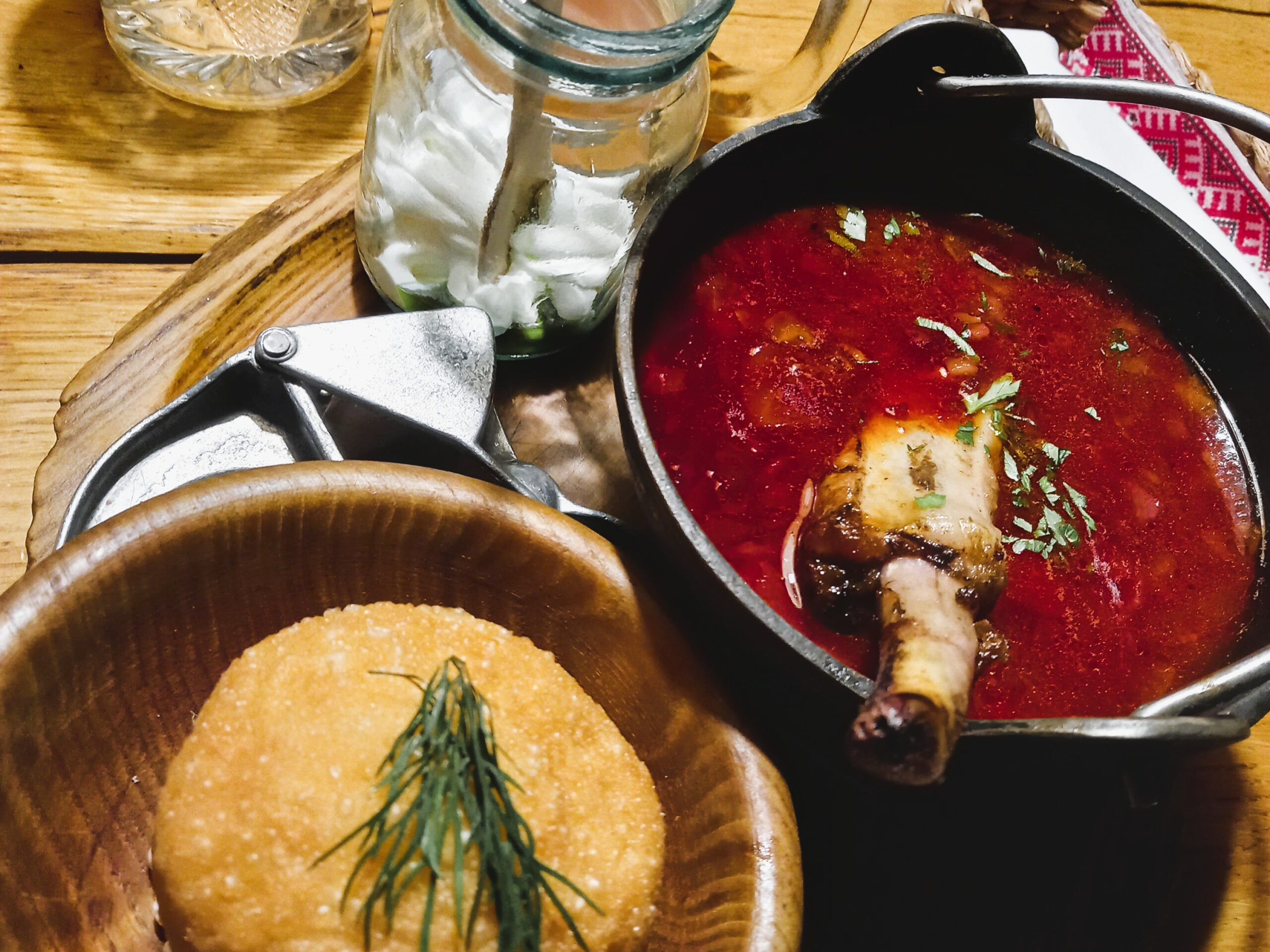
(Borscht & sour cream, Staryy Mlyn restaurant, Ternopil, July 2024)
The All-Purpose Condiment
“Duzhe dobre, dyakuyu”!
Learn these words by heart, write them on your phone or notepad. Hell, tattoo them on your forearm if that’s what it takes, because it will determine whether your arteries are getting morbidly clogged — sending you to an early meeting with your maker — or not. “дуже добре, дякую” means “very good, thank you”, words that you will utter relentlessly at any table in the sunflower country, to politely decline yet another dollop of sour cream from being poured for the fifth time onto whatever is in your plate, bowl or cup.
The sour cream becomes THE dish, while the other delicacies on your plate become mere accompaniments, drowning in this pleasant, buttery intruder. Such is the rhythm of dining in Ukraine.
Every country has its all purpose flavourings. The Chinese have their Lao Gan Ma chili crisp, my fellow frenchmen have their Dijon mustard — although I prefer my Pommery whole grains — whilst the rest of the world have succumbed to Sriracha-like hot sauces, so it appears.
With our Hopak dancing European neighbors, the sour cream is omnipresent, never out of sight, always reachable, ready to be indulged upon. This fermented dairy product is — unlike other condiments — the star of the show, not simply an afterthought to hide an under seasoned, insipid plate, but the mandatory finishing touch bringing flavours to new heights. This love for sour cream isn’t just a culinary quirk — it reflects a deep-rooted part of Ukraine’s culture and hospitality.
These following paragraphs are as multipurpose as this piece’s theme. They will be a love letter to a cruelly mistreated country, as much as a call for us westerners to support it. But rather than brandishing the current gloomy situation facing Ukraine, I will instead solicit your senses – not your pathos – through a cultural & culinary journey, as a call for action.
The Taste of Travel: How Flavors Define Destinations
As a former student and worker in the tourism & hospitality sector, I was quick to realise that cuisines are integral parts of any destination. Our desire to explore different cultures could not be more tangible than savouring a local delicacy, releasing its flavour onto our virgin foreigner’s palate. Travels are inherently sensory journeys, and the memories tied to a location are built through how we consume it, in a figurative and literal sense.
I would not remember — even if I wrote it in a travel journal — the few hours I spent in Alba, Italy, over a decade ago, if it was not for the intense omnipresent smell of hazelnut-chocolate in the air. Home to Ferrero’s headquarters and factories, the Nutella-like scent that envelops you the moment you enter the town is impossible to escape, and equally impossible to forget. I assume it could have been worse, for instance if that fragrance would be of capers, my all time phobia. Ironically that would have been as memorable, but for a wholly different reason.
Or the first time I tried one of Hong Kong’s many delicacies: roasted goose. I cannot disconnect the street Jardine’s Bazaar in Causeway bay from that experience. In true Hong Kong fashion, the service was swift and efficient. Mere minutes after being seated, a plate of roasted goose arrived. My gweilo (“westerner” in Cantonese) genes kicked-in immediately by being unable to eat the goose, thanks to my lackluster chopsticks skills. The waitress brought me with a gentle pity — although insultingly for me — a fork and knife to avoid the poor animal from flying onto the ground or on my neighbour’s table. Just as Hong Kong’s roasted goose remains seared in my memory, so too would Ukraine’s culinary identity leave an unexpected mark.
Going for a humanitarian mission in Ukraine in the summer 2024, I did not know anything about the country’s culinary scene. In all candour, it was not really in mind at all, as the only objective for going into a war-torn country was to help its people, and nothing else. However it took me only a few days after arriving to realize that Ukraine is a cultural powerhouse. And at the forefront of this significant cultural heritage, is none other than its cuisine.
Ukraine’s Culinary Powerhouse
French cuisine has been crafted and perfected through centuries, but the refinement and systematization of modern French cuisine is recent, and could be attributed to French Chef Auguste Escoffier in the late 19th century (a painful fact for French culinary chauvinists). This distinct culinary art, shaped by centuries of relative territorial stability, allowed chefs to refine their craft without disruption.
However, tracing the roots of Ukrainian cuisine is far trickier. That is the direct expression of the country’s complex history, which has seen a relentless pendulum of powers, shifting hands between invading powers, suffering waves of conquest and oppression. From Mongol-tatar, Lithuanians, Hungarians, Poles, Germans to Russians, the nation as we know it today only became truly independent after the fall of the Soviet Union in 1991, after centuries of struggle. Despite this instability, Ukraine’s cuisine flourished, anchored by its second greatest asset, a gift from Demeter herself: its soil.
The term “Ukraine, breadbasket of Europe” is not unfounded. The country was blessed with the most fertile soil in Europe. Called “Chernozems”, this black soil occupying two thirds of the territory has been able to form, thanks to a fine balance between steppes and prairie biomes and their interaction with wet, dry and frost seasons typical of the region.
Few realize that this nation quietly holds the keys to global food security — ranking as the world’s top exporter of sunflower oil, third in barley, fourth in maize, and fifth in wheat. We can remember how The Russian invasion — with its Black Sea blockade and deliberate targeting of Ukraine’s agricultural infrastructure — caused global grain prices to surge by 15% in just one month (according to the EU commision). The ripple effect deepened food insecurity, particularly in Africa, leaving millions of families more vulnerable than ever to hunger and hardship.
One can remember how the Arab Spring started in 2011, with inflation hitting food prices plunging the entire region into years of protests and revolutions. Lenin’s quote that “every society is three meals away from chaos” could not be more true, and is further proof — as if there were not enough already — that Ukraine’s safety, security and independence is paramount, for all our sake.
I think that we have reached the point of the piece where I am obliged to set aside my historical and economic ramblings and focus on the meat and potatoes of the topic (pun aside).
Undertaking an accurate account of all my culinary experiences in Ukraine during those three months would be a sisyphean task, bound to fail miserably. I couldn’t possibly do it justice. Instead, let me take you to one corner of this culinary universe — a bustling open-air market southwest of Lviv.
The calm before the storm
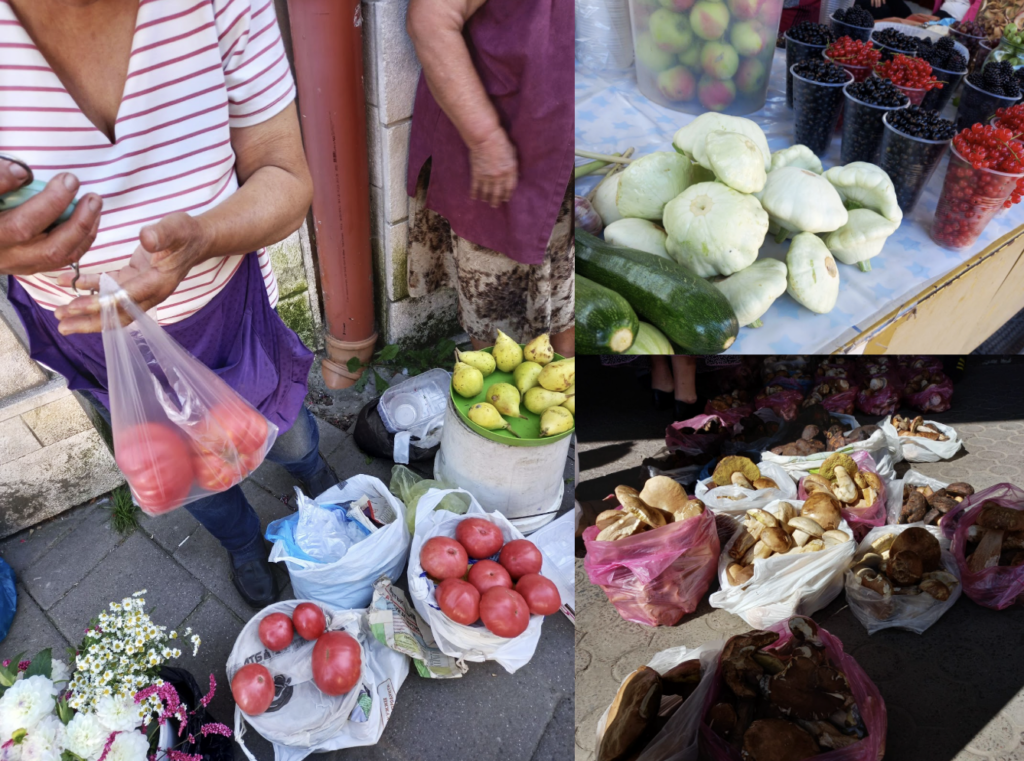
(Outside vendors. Lviv, July 2024)
Standing outside Pryvokzalʹnyy Rynok on a late Saturday morning feels exactly like what one would expect from a local market: crowded, chaotic, with sweet old ladies clearly operating without any licenses or permits, trying to sell you their dodgy homegrown everythings. As a side note, the term “grandma” in Ukrainian is “Babusya” with a “y”, unlike the Russian version, “Babushka” with a “K”, a small difference to be mindful of, especially in those turbulent times when Russian speaking is admonished, at least in central/western Ukraine.
Nothing at first sight would indicate any differences with most markets across Europe, that is until you walk closer and notice the sizes and portions being offered by the outside vendors. It is hard to fathom grape-sized blueberries, yet in Ukraine it is as unremarkable as trimmed artichoke hearts in any northern-Italy vegetable stall. And then there is the serving size: forget about your little, measly plastic punnet-packed berries sold at eye-watering prices, in the land of Zaporozhian Cossacks, they have swapped it for massive one liter buckets. Buy it all or buy none, although considering the price of 50 hryvnias (roughly 1 Euro) a piece, you might as well go home with 1, if not 3.
Now a luxury in western Europe, I have shamelessly overdosed on berries in Ukraine, not unlike what one would do in Colombia or Ecuador. I wager I have gulped enough vitamin C and antioxidants for the rest of my life.
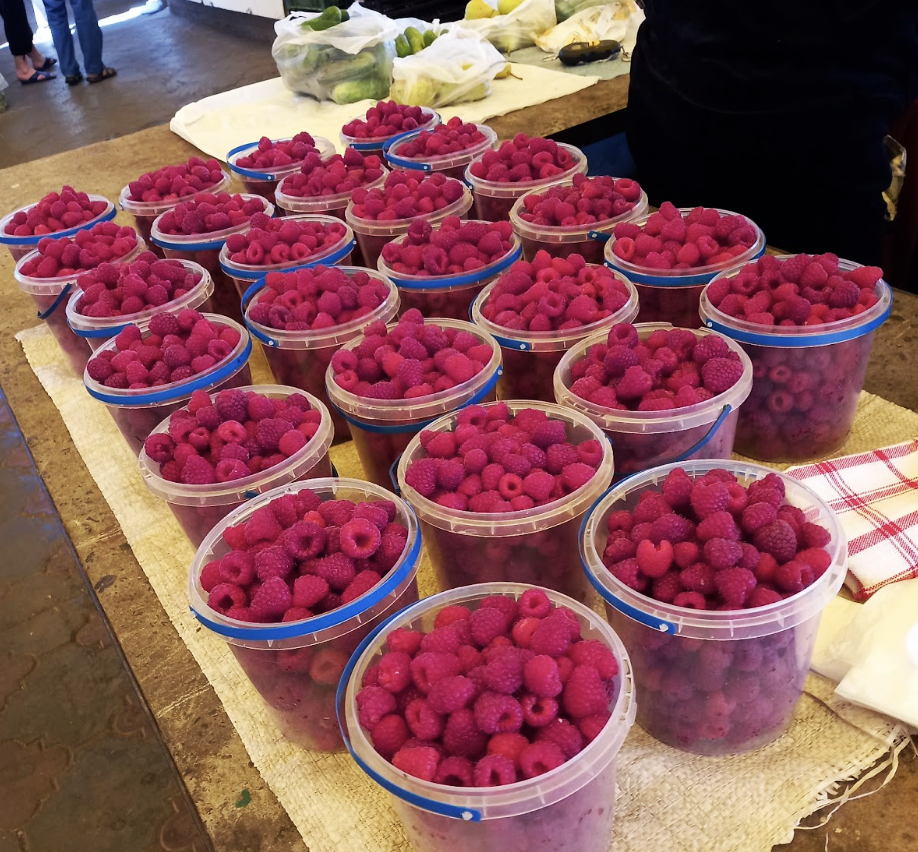
(“One liter raspberry buckets”. Lviv, July 2024)
These berries, which grow abundantly both in the wild and in cultivated fields across Ukraine, are a staple in numerous dishes. Yet if one culinary creation deserves special mention, it’s the iconic half-moon-shaped dumplings known as Varenyky — a beloved delicacy that dates back to the Middle Ages. While dumplings are common worldwide, Ukrainians have elevated them to an art form, filling them with both savoury and sweet ingredients, always accompanied — naturally — by a generous dollop of sour cream. The sweet variety, reminiscent of delicate berry ravioli, comes stuffed with cherries, cranberries, raspberries, strawberries, or sometimes a delightful medley of all four.
I remember once walking in the countryside along a suspiciously well maintained road – a rarity in Ukraine – in Riveneska “oblast” (a region in Ukrainian). Coming up on my left was a neatly decorated house with a small field in the garden. As I got closer I realized that those crops – about 10 rows, 30 meters long each – were packed full of raspberries and blackberries. In between them, I spotted a elderly man with his typical beret and plaid shirt collecting the fruits with his granddaughter, no older than 4. I figured that, considering the size of the field, he was selling his fruits in local markets. I waved at him from outside the fences in the hope to go back home with a bucket or two of his latest harvest. After the friendliest of chats – through google translate, it transpired that his fruits were just for his personal consumption, to my greatest disappointment. That is this nation’s countryside in a nutshell: fruit trees and crops can grow anywhere with such ease, nearly becoming a nuisance more than a gift, as ripped fruits lay everywhere on the ground, slowly fermenting in the blazing summer sun.
Finally, as I reflected on those sweet moments in Lviv — barely resisting the urge to buy everything from the bustling outdoor stalls — I found myself at the market’s entrance, ready to immerse myself in the heart of Ukraine’s culinary abundance.
Entering the Garden of Eden
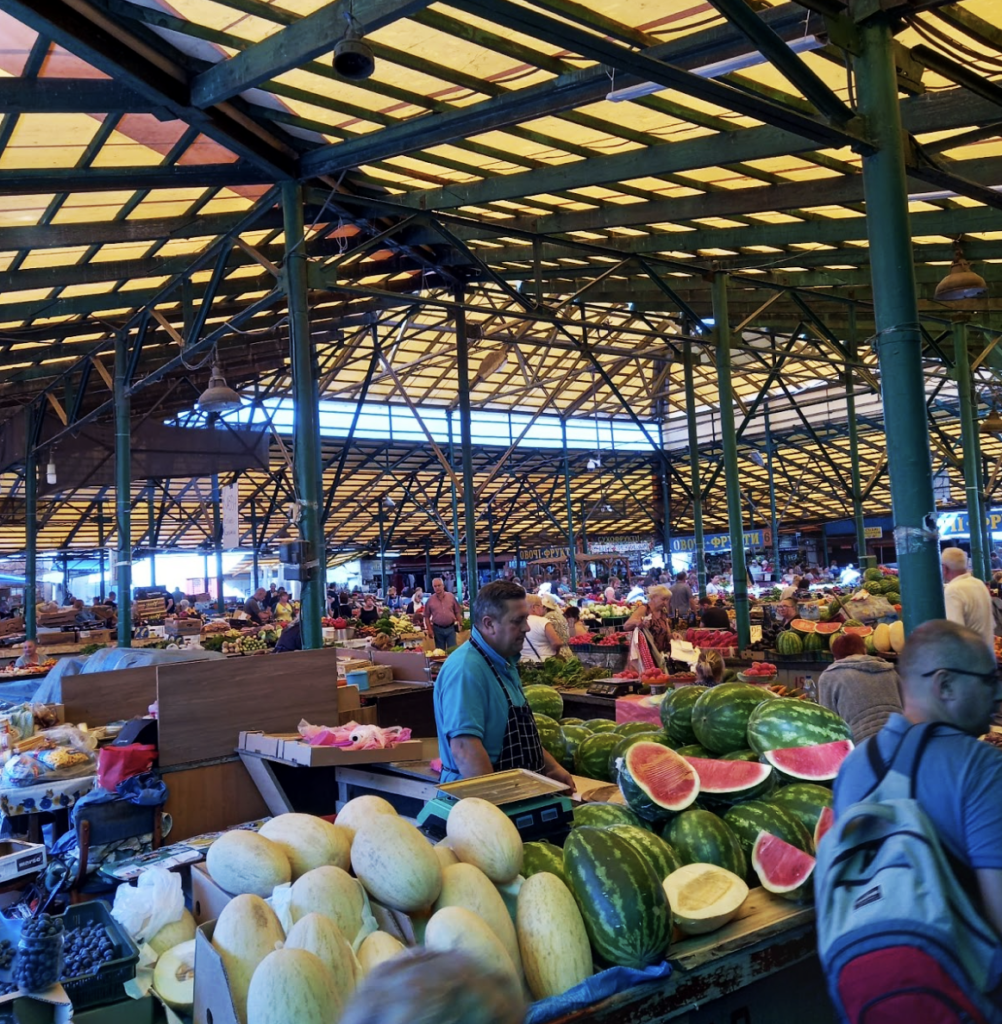
(Vegetable section of the market. Lviv, July 2024)
Now it is time to go through the gates and enter this temple, a sort of Garden of Eden where the variety and quality of the products displayed would make anyone question if Eve ever sinned by taking a bite of that fateful apple, allegedly. Having needlessly dug myself in this Christian lexicon, I will double down by introducing you to the holy trinity of Ukrainian vegetables: beetroots, cabbages and potatoes.
Truthfully, a fair bit of national dishes are supported by and/or mainly composed of those three components: Holubtsi (stuffed cabbage rolls), Deruny (potato pancakes), or braised cabbage. Hence it is no surprise that, the holy grail of Ukrainian cuisine, combines all of them elegantly together, with of course sour cream dollop toppings as the bidding ingredient and dill as the chief aromatics. I am evidently talking about the mother of all soups – a delicate balance between meat stock, fried and boiled vegetables, freshly cut herbs and tangy tomato concentrate & ketchup – the Borscht. But more on that later.
I did not stumble upon this market out of sheer luck, but went there with a purpose: get all the ingredients to prepare a generous Borscht for my farewell dinner. I came with a precise shopping list, which – within the first few minutes after arriving in the market – was rendered useless: I wanted to buy e.very.thing.
The pristine condition of those ingredients will spur in any foodie’s soul an avalanche of creativity. Barely two steps in, and you can spot on your right side a whole booth of brightly colored bell-peppers, the size and price of which cannot be fathomed for a westerner. I ended up going home with two entire shopping bags of those and did a Michelin-worthy velouté (with sour cream, is it even worth mentioning it at this point).
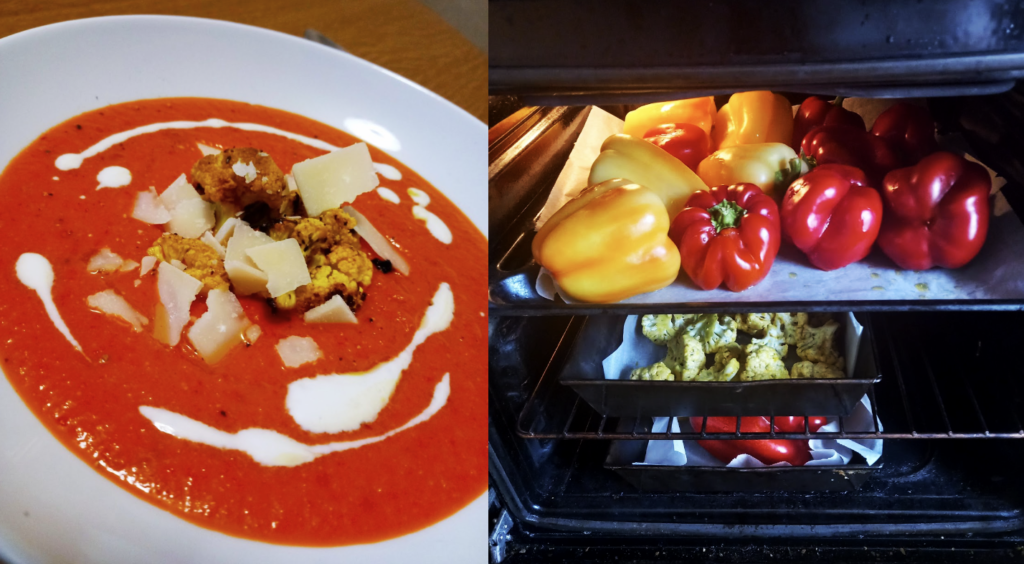
(Roasted bell pepper velouté. Lviv, July 2024)
Another few additional steps and you will get immobilized by a literal wall of honey buckets. All homemade, of any variety, crop or fruit type: Orange blossom, lavender, chestnut, sunflower, buckwheat, acacia… I initially managed to get around this seemingly unbreachable wall, going for the dry section.
Ukrainians are also masters of curing & drying food: from salted and dried sturgeon fillet in the south-west near the Azov sea and “Salo” salted lard, to the smoked dried plums and pears used to make what became my favourite beverage, Uzvar. This drink, consumed cold or hot, is an infusion of dried apricot, apple, prunes, orange zest and chiefly, smoked pears, the key ingredient. It is impossible in any circumstances to miss that distinct smokey smell when nearing that booth. Not necessarily pleasant on its own, this strong fragrance is nonetheless of the most subtle finesse on your palate, especially when the beverage is balanced with a sweet tablespoon of honey… After buying all the dry components, I had to go back to the honey booth to finally make my own Uzvar, damn you Ukraine! (I settled on buckwheat honey, a staple in French Brittany, my ancestors would be proud).
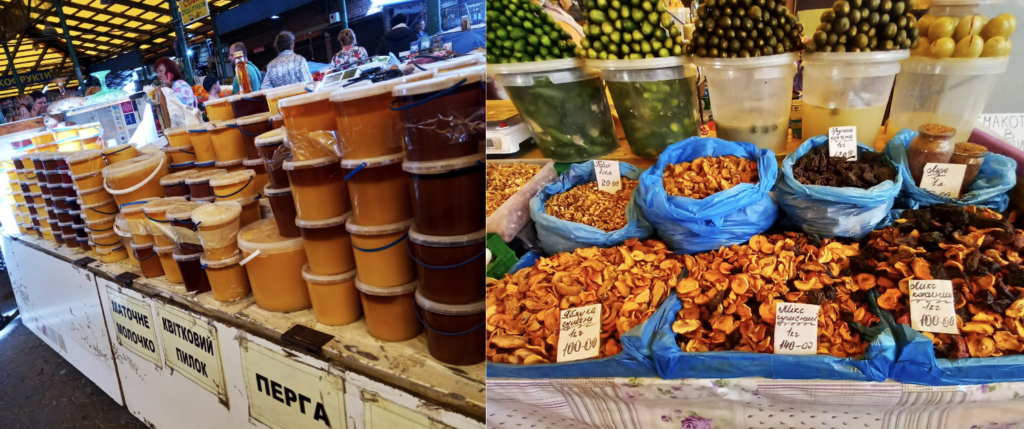
(wall of honey & dried section. Lviv, July 2024)
Now ten minutes in, having bought all the ingredients for my Borscht, Uzvar and velouté, I had already exceeded the quantity I could physically bring home. Luckily, I was accompanied by a second pair of arms, thus the buying spree had no reason to stop. From afar I saw a very intriguing section, the vinegary smell of which could be detected from where I was standing. Drawn by curiosity (and cravings for culinary oddities), I found myself instinctively moving toward its source before my conscious mind had even caught up.
Pickling amateurs can probably guess where I was headed. It also turns out that, amongst all their culinary wizardry, Ukrainians are also master picklers. Because of the country’s climate and brutally cold winter, seasonal products have to be stored properly for the colder months. The simplest and safest way is by immersing just about anything in a vinegar and salt brine. Words struggle to capture the sheer variety — from whole cabbages to vibrant chilis, each jar a vibrant splash of color.
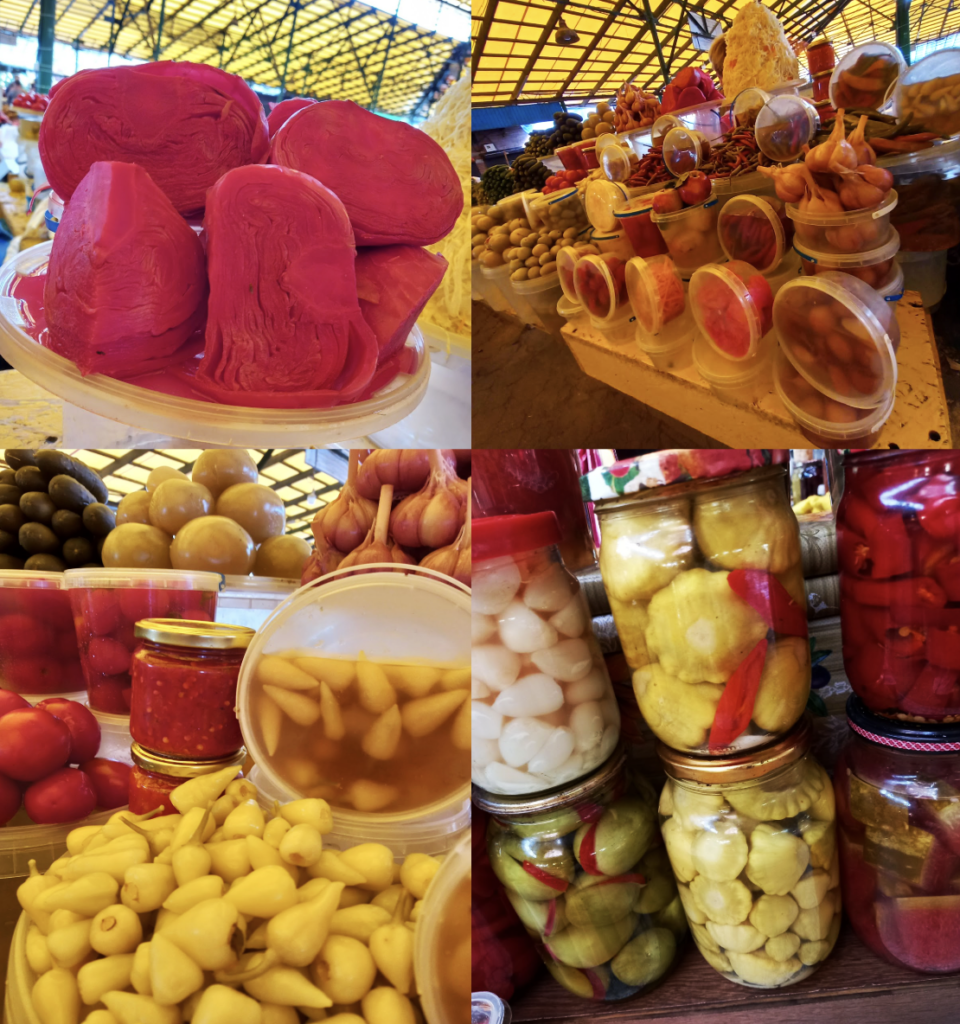
(From top to bottom, pickled: whole cabbages, garlic, onions, apples, gherkins, cucumbers, green and red chilis, carrots, beetroots, baby squashes. Lviv, July 2024)
If I have not gotten readers salivating with these few pictures, then we’re not cut from the same cloth. I succumb at the sight of earnest authenticity, as much as I am repelled by photogenic, instagrammable superficiality. This market ticks all the right boxes.
The Dairy Crown Jewel
Until now one element was crucially missing. I could not spotout amongst those colourful stalls any sour cream. Hidden in between two vegetable sellers, a lady was standing quietly, with only in front of her a spatula, scale, large white bucket and plastic bags. Getting closer to her little installation, I knew the sour cream would be of the finest quality. Non-initiated would probably picture sour cream as this immaculate white, yogurt like textured ingredient. That is if you have only tried the store-bought one. Instead swap the white for a pronounced yellow colour, and the yogurt for butter-like density. But the most striking difference, however, was the scent. It hit me immediately — an unmistakable aroma reminiscent of a dairy farm. For a cheese-loving Frenchman like myself, this was anything but unpleasant — it was a promise of authenticity. After a quick taste generously offered by this dairy virtuoso, I proceeded with getting a whole plastic bag worth of it. I needn’t worry about it leaking in my shopping bag as the fat content made the cream nearly as solid as a fresh pasta dough.
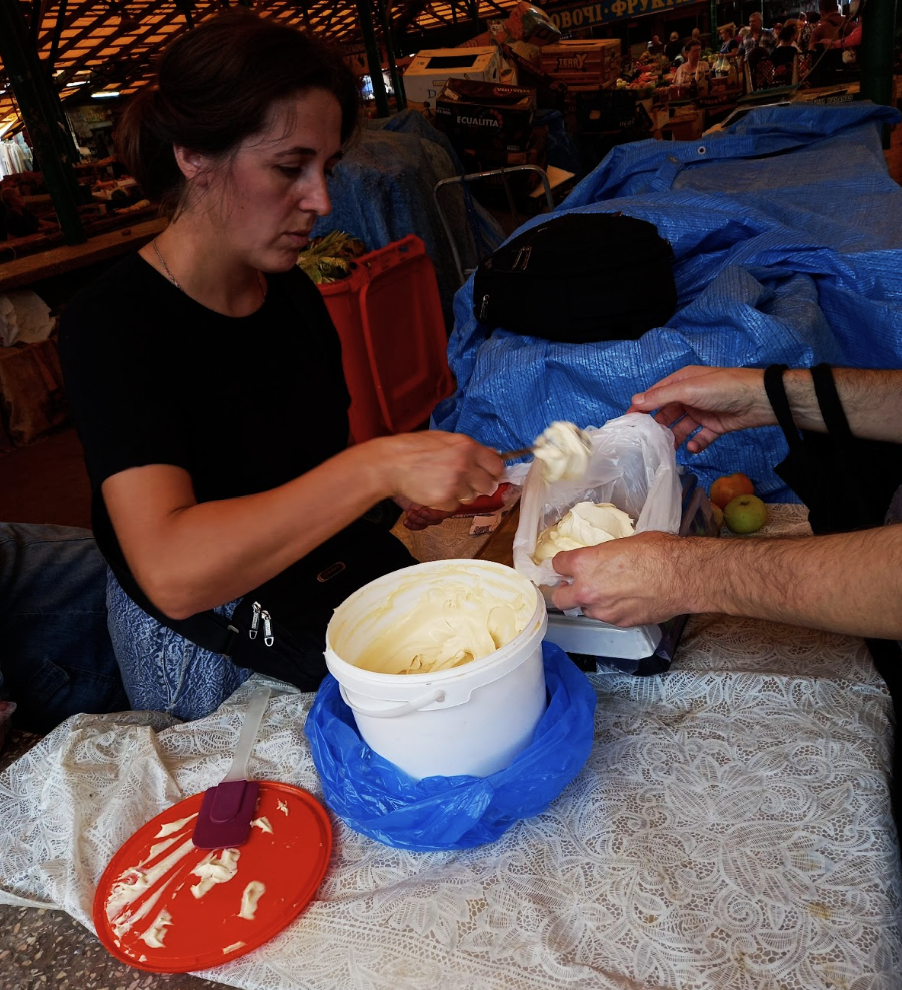
(Sour cream stand, Lviv, July 2024)
But in Ukraine, sour cream is more than just a condiment, it is also a direct expression of Ukrainians’ warmth and hospitality. There are no places, whether in restaurants or at home, where these brave people would not sacrifice their very fragile comfort – especially in times of war – to welcome strangers and share a meal. As part of the humanitarian mission I was in, we travelled throughout the countryside to attend isolated internally displaced shelters and military hospitals. No matter how desperate their situation was – having had to leave their homes, their villages and towns reduced to rubble under russian artillery fire – they would welcome us with open arms. Each time we arrived at a new location, Ukrainians managed to give us more than we would give them.
There are few memories more alive in me than being treated to an improvised five course meal on a makeshift table, outside a small village orthodox church. The food was prepared in its entirety by the parish’s Babusyas: homemade cottage cheese varenyky, paired with a vegetable broth and its whole cup worth of divine sour cream (1 cup per person). And for dessert a pancake trio filled with curd cheese, raspberry and chocolate, smothered in a decadent, stracciatella frosting.
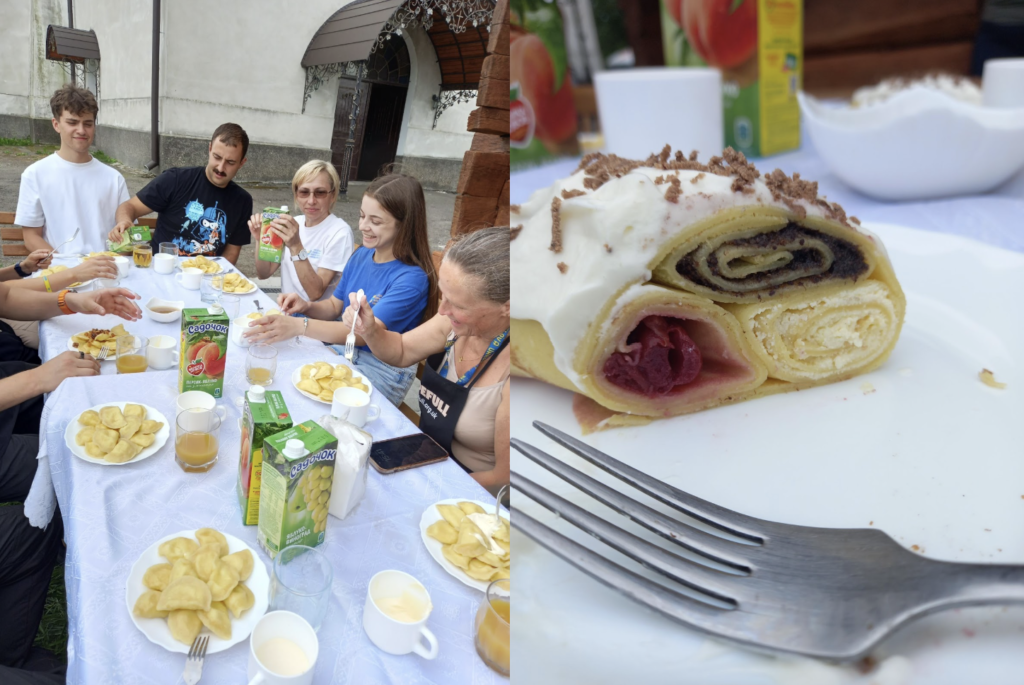
(Verenyky feast accompanied with sour cream cups & crepe trio dessert, July 2024)
It is tough to fathom the hardship they are going through due to Russia’s invasion. Never once the atrocious human cost of the war is out of sight.
Late July 2024, we were greeted in a town’s representative home, after barely surviving a 4 hour drive in the pothole ridden road network. The grandmother prepared lunch with the love and care I had never – nor will ever – deserve. I was elated whilst savouring her succulent Bortsch and its single large dice of marinated beef shank, melting in my mouth. Paired with this bright-ruby soup, came the mandatory Derunys and minced pork & buckwheat Holubtsis. On that dining table, a single large cup of sour cream was being passed around, or rather amicably fought for. Picture six strangers and the representative being served by his wife and mother, whilst at the back of the living room, in the corner, was displayed a photograph of the host’s dead brother, Yuri, killed barely a year earlier.
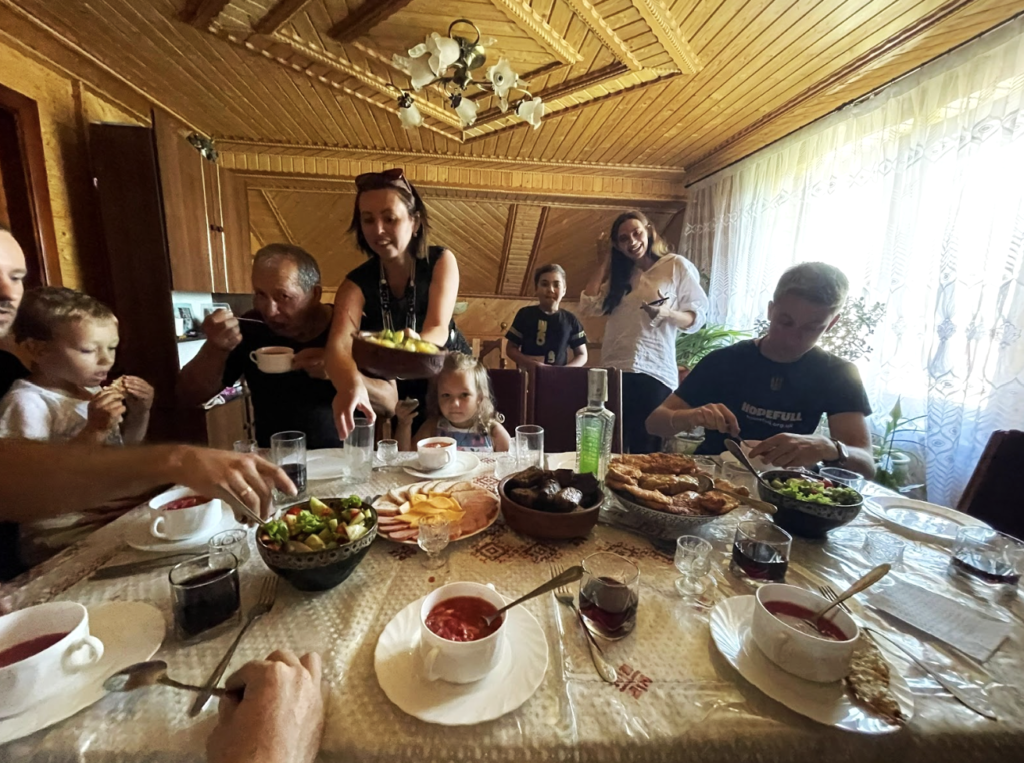
(Borscht & co at representative’s house, July 2024)
Ukraine’s Revival
As I write this on the 8th of March 2025, the world watches Ukraine with a mix of hope and uncertainty. I am like most EU citizens dismayed by the American strategic volte-face. From helping Ukraine “as long as it takes”, to “as long as we can” from Biden last year to calling Zelensky “a dictator without elections” by Trump is the most abrupt switch ever seen in American foreign policy history. Yet, despite the despicable behavior from the Oval Office, one fact remains: the war is heading toward uncharted territory — one defined by both escalating conflict and the fragile hope for peace.
In the near future, Ukraine might be able once again to experience a nearly forgotten feeling after a decade of war: freedom. In reopening the borders for Europeans, I envision a country that will become the success story of the 21st century. A country that is allowed to join NATO, the EU, and finally enjoy fully its long fought for and bloody independence. Investment should pour into Ukraine, in all forms: through loan programs, public and private investments, EU development funds and last but not least through the seizure of Russian assets. According to a joint report by the World Bank, the United Nations, European commission and Ukrainian government, the total cost of rebuilding the country and reviving its economy stands at $525bn.
But the reconstruction cannot be done through financial aid alone. We Europeans should flock to the country and physically help to rebuild it. Tourists could enjoy all that Ukraine has to offer – from architecture to food, to Odessa’s seaside retreats – whilst at the same time helping its people. This isn’t just travel; it’s a new form of humanitarian tourism — one that blends cultural discovery with meaningful impact. History offers countless examples of this approach: post-war Yugoslavian countries, the recovery of Cyprus, and even Rwanda’s return to stability. Ukraine’s tourism system — decimated by the Maidan revolution, the Crimean invasion, and the full-scale war since February 24, 2022 — can achieve a remarkable rebirth. With tourists returning, small businesses rebuilding, and cultural ties strengthening, Ukraine’s economic recovery can flourish from the ground up.
But before this vision becomes reality, there’s something we can all do right now: educate ourselves. Ukraine’s survival has come at a tremendous cost. The least we can do is honor their resilience — by learning their history, celebrating their culture, and savoring the richness of their cuisine. Open a Ukrainian cookbook, prepare a hearty Borscht or a golden Kyiv chicken, and crown it all with the only fitting condiment — a generous dollop of sour cream.
Find all Ukrainian recipes HERE
~
Sources:
Anadolu Agency. (2024). Biden changes tone amid aid deadlock, says US will support Ukraine ‘as long as we can’. https://www.aa.com.tr/en/americas/biden-changes-tone-amid-aid-deadlock-says-us-will-support-ukraine-as-long-as-we-can/3080942
BBC News. (2025, February 25). Ukraine reconstruction costs cross half-trillion-dollar mark. https://www.aljazeera.com/news/2025/2/25/ukraine-reconstruction-costs-cross-half-trillion-dollar-mark-report
Britannica. (n.d.). Auguste Escoffier. Encyclopædia Britannica. https://www.britannica.com/biography/Auguste-Escoffier
Britannica. (n.d.). Hopak. Encyclopædia Britannica. https://www.britannica.com/art/hopak
Britannica. (n.d.). Ukraine – Soils. Encyclopædia Britannica. https://www.britannica.com/place/Ukraine/Soils
Business Insider. (2022, December). Sriracha’s David Tran: The immigrant behind the iconic hot sauce. https://www.businessinsider.com/sriracha-david-tran-huy-fong-immigration-food-history-aapi-2022-12
Consilium Europa. (2022). How the Russian invasion of Ukraine has further aggravated the global food crisis. https://www.consilium.europa.eu/en/infographics/how-the-russian-invasion-of-ukraine-has-further-aggravated-the-global-food-crisis/
Dobromishev, K. (n.d.). History of Ukrainian cuisine. Medium. https://katedobromishev.medium.com/history-of-ukrainian-cuisine-52ddcc1ca3f8
Ferrero. (n.d.). Our heritage rooted in Alba, Italy – where it all began. https://www.ferrero.com/int/en/about-us/quality-at-heart/our-heritage-rooted-in-alba-italy-where-it-all-began
Forbes. (2019, August 4). Yugonostalgic tourism: Can a communist history turn into a business?. https://www.forbes.com/sites/rebeccabanovic/2019/08/04/yugonostalgic-tourism-can-a-communist-history-turn-into-a-business/
NPR. (2013, January 29). Classic comfort dish: Chicken Kiev got its start in France. https://www.npr.org/sections/thesalt/2013/01/29/170595236/classic-comfort-dish-chicken-kiev-got-its-start-in-france
Olga in the Kitchen. (n.d.). Deruny. https://www.olgainthekitchen.com/deruny/
OpenRice. (n.d.). Ki’s Roasted Goose Restaurant. https://www.openrice.com/en/hongkong/r-ki-s-roasted-goose-restaurant-causeway-bay-hong-kong-style-chinese-bbq-r602166
ScienceDirect. (n.d.). Chernozem. https://www.sciencedirect.com/topics/earth-and-planetary-sciences/chernozem
ScienceDirect. (2024). The economic impact of war on Ukraine’s recovery. https://www.sciencedirect.com/science/article/pii/S0160738324001336
Tara’s Multicultural Table. (n.d.). Mamushka Cookbook Review: Uzvar. https://tarasmulticulturaltable.com/mamushka-cookbook-review-uzvar/
The Center for Climate & Security. (2013). The Arab Spring and Climate Change. https://climateandsecurity.org/wp-content/uploads/2018/07/the-arab-spring-and-climate-change_2013_02.pdf
The Guardian. (2022, November 5). China’s hottest woman: The driving force behind crunchy chilli sensation Lao Gan Ma. https://www.theguardian.com/world/2022/nov/05/chinas-hottest-woman-the-driving-force-behind-crunchy-chilli-sensation-lao-gan-ma
Ukrainian Flavors. (n.d.). Varenyky: Ukrainian culinary heritage. https://ukrainianflavors.com/blogs/blog-uf/varenyky-ukrainian-culinary-heritage?srsltid=AfmBOooEL3DlOAkxHPTejLP65hg2AjujQQ7vFfl1e3EBfLYW1PCW6Wut
Ukrainian Recipes. (n.d.). Ukrainian Borsch. https://ukrainian-recipes.com/ukrainian-borsch.html
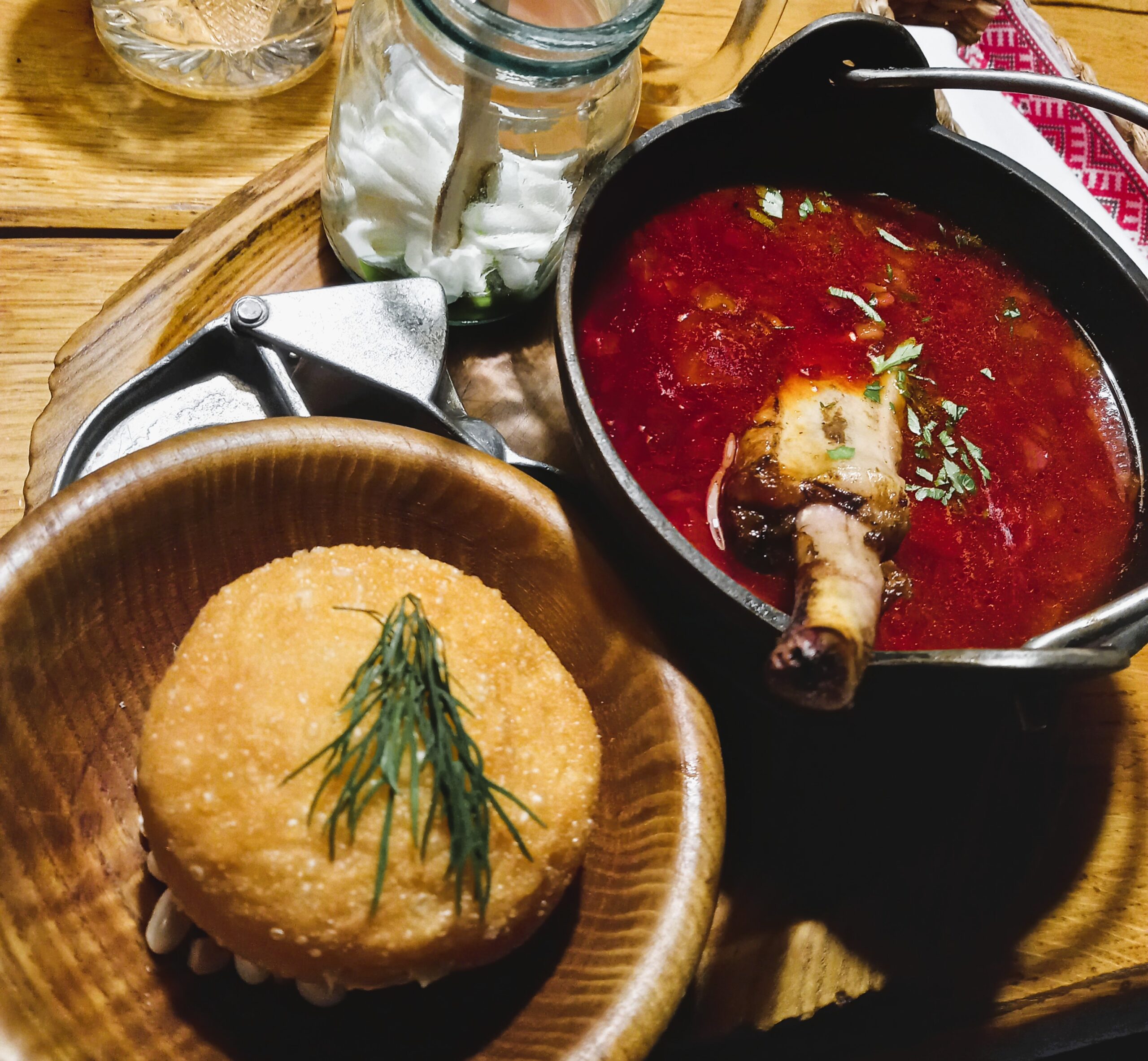
Leave a Reply